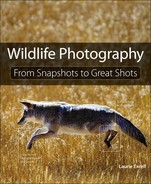10. Birds of a Feather
A Visit to One of My Favorite Bird Photography Hot Spots
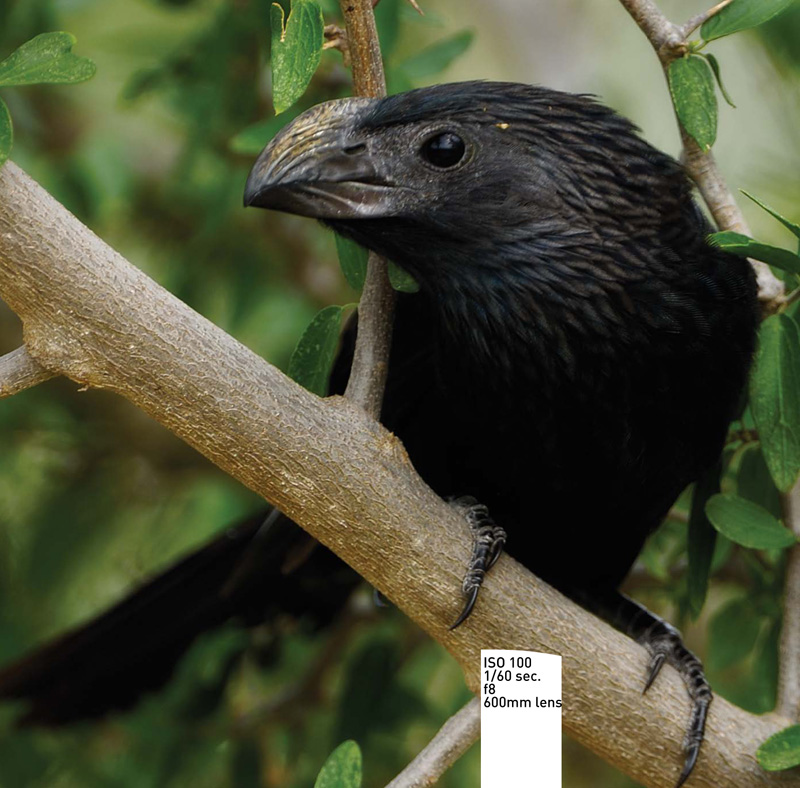
For every type of bird, there is a best location and a best season. Putting it all together is what ensures a successful photographic adventure. Although I love to scout and find new locations, I have a few favorites that I can’t seem to miss each year. In this chapter, I’ll share one of my favorite bird photography hot spots with you. This adventure takes place in the deep south near the Mexican border in McAllen, Texas, where many ranchers are opening up their property to photographers so that you can visit and photograph the local residents and the migrants that pass through at certain times of the year. When I say the photography in South Texas is hot, I don’t mean just the outstanding variety of birds (we counted 47 species one week); it’s HOT! So, pack your shorts and T-shirts, and let’s go.
Poring Over the Picture
Finding a natural perch is part of making a great shot. I see so many Scissor-tailed Flycatchers on wires in Texas that it almost seems natural.


What (Equipment), When, and How
I already know the what (birds) and where (South Texas ranches) my next adventure will lead me to, so I then have to figure out the best time (the hotter, the better) to go, how I will get there (small commuter plane to McAllen, Texas), and what equipment (Figure 10.1) I will need and how to get it there.
Figure 10.1 The 600mm f4 VR is my lens of choice when it comes to photographing birds.

What Equipment
When it comes to bird photography, I pull no punches and go straight to my 600mm along with all three teleconverters. Small birds take all the reach you can get (Figure 10.2). In South Texas photographing from blinds, I also have my extension tubes close at hand. The rest of my gear is pretty much the same as in Chapter 9, “Bear Tales,” with the following changes:
• Nikon AF-S 70–200mm 2.8 VR II in place of the 70–300mm VR for the increased speed and the ability to add teleconverters reaching to 400mm with the 2X.
• Gitzo GT5541LS in place of the GT3541LS due to the increased weight of my 600mm lens.
• Lightning Trigger; hey, it could (and has) happened!
Figure 10.2 Adding a 1.7X teleconverter to my 600mm gave me 1000mm, increasing the size of the Painted Bunting in the frame.
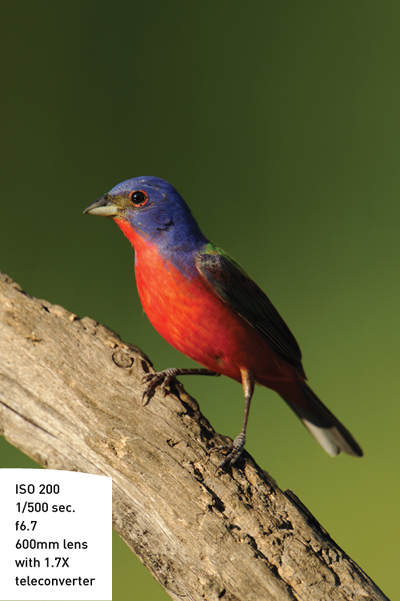
What Clothing and Gear
On location, it’s hot, it’s muggy, it’s prickly, and it’s buggy! Oh, yeah, and you’re in a blind (box) with very little ventilation. I don’t want to scare you away; I just want to warn you to dress accordingly by wearing lightweight clothing that wicks away moisture and closed-toed shoes to avoid stubbing your toe into a cactus. Here are the items you should have with you:
• Shorts and T-shirts rather than thermal underwear and fleece, and well, nearly everything else on the list in Chapter 9. You will live in shorts and T-shirts!
• Sunglasses, hat, sunscreen, and bug spray are on the list in Chapter 9, but I want to place special emphasis on these items. You will definitely need them.
• Snakebite kit. You think I’m kidding (Figure 10.3)? Seriously, while on the lookout for snakes to avoid getting bitten, we also watch out for them as additional photo opportunities.
Figure 10.3 They grow things big in Texas, and snakes are no exception. This guy was at least six feet long.

When
There are birds in South Texas all year round; but for the best bird photography, prime time is spring through early summer. It’s nesting season, it’s migration time (midway through the season), it’s hot, and the birds flock to the rare and essential water sources (where the blinds are strategically placed) to drink and bathe (Figure 10.4). The last week in May is my preferred time to be there, but I’m told it’s even “hotter” (the photography and the temps) in June. I’ve been meaning to give it a go some year. Spring also brings with it mating and nesting behavior among the birds. So you always need to be on constant watch for a bird carrying nesting material or exhibiting mating behavior for interesting photographs (Figure 10.5).
Figure 10.4 When it’s hot out, place yourself at a water source; the birds will come.
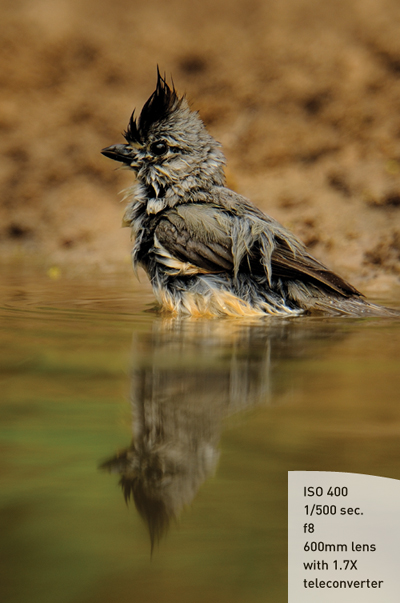
Figure 10.5 Northern Mockingbird calling to its mate.
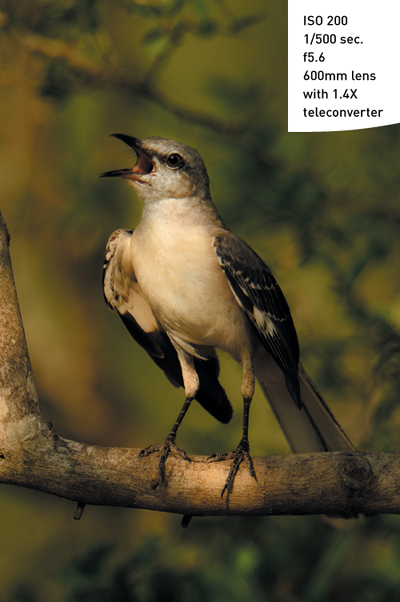
How
Two planes from Portland, Oregon, to McAllen, Texas, covering over 2,100 miles and 8-½ hours of travel time, put me in South Texas. An hour’s drive gets me to the lodge, where I’ll make my base for the next week. The itinerary consists of two shoots daily, beginning with a quick continental breakfast before heading out to the blinds, setting up, and being in place before sunrise. Once situated in the blinds, I won’t leave for several hours, so it’s important to pace myself on my fluid intake. If I leave the blind, I flush the birds. It’s as plain and simple as that. So, upon my arrival, I quietly wait for them to resume their activity that I interrupted. And resume it does, as one species of bird (Figure 10.6) after another comes to the water, allowing me to train my lens on them long enough for a few photographs before the next subject (Figure 10.7) takes its place.
Figure 10.6 A Great Kiskadee perches before going to the water. The key to great shots is the strategic placement of and types of perches.
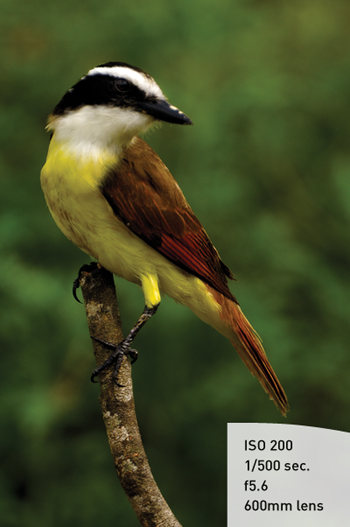
Figure 10.7 A Golden-fronted Woodpecker calls to its mate in a nearby tree.
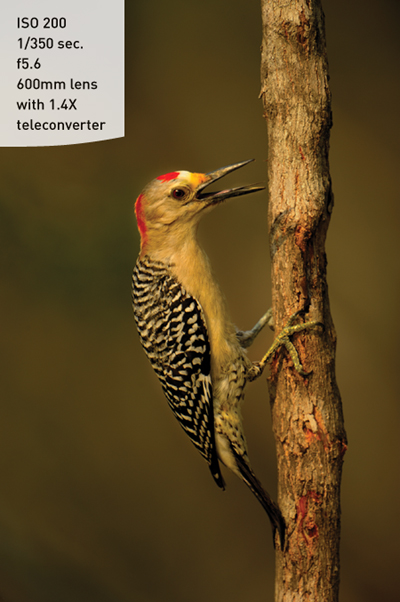
When the sun gets high in the sky throwing hard shadows against the bright dirt and the temperature starts its upward climb, I too climb out of the blind and head back to the air-conditioned lodge. I’ll upload the morning’s images, have lunch, and take a break during the hottest hours before heading back to a different blind that is situated for afternoon light for another 3-to-4-hour session of bird photography (Figure 10.8).
Figure 10.8 A Green Jay is one of my target birds when photographing in South Texas. It is not common in many other locations.
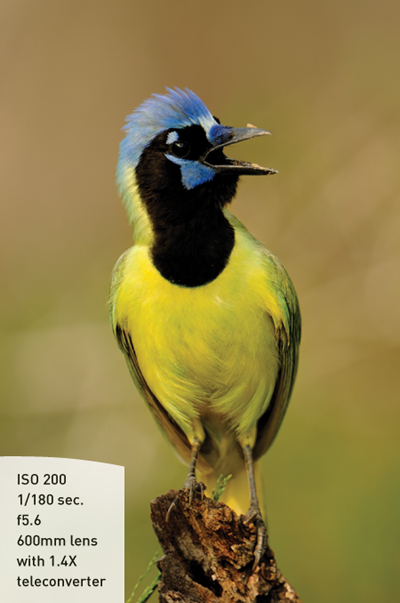
Blinds are placed for either morning or evening light. I enjoy several afternoons at the raptor blinds photographing the Harris Hawk (Figure 10.9) and the rare Cara Cara (Figure 10.10) vying for position to get the prize of a meal of raw meat.
Figure 10.9 A Harris Hawk perches in the crook of a tree checking the area for danger before going to the bait.
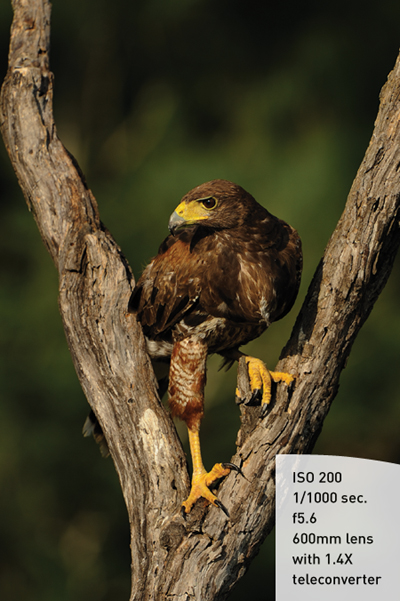
Figure 10.10 A Cara Cara flies low over the fields of yellow flowers that spring rains have nourished.
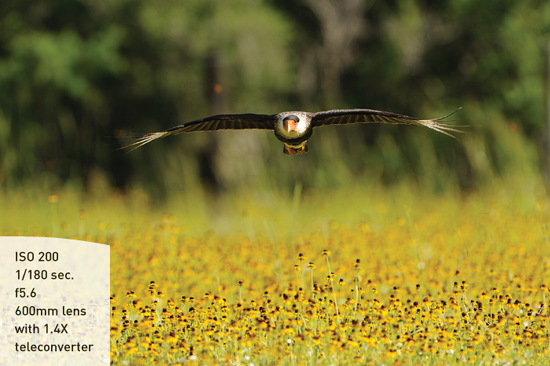
Photographing the birds of South Texas is just like shooting fish in a barrel. You simply go to the water source on a hot spring or summer day and tuck yourself into a blind for a few hours of enjoyable wild-bird photography.
Chapter Assignments
Bird photography can be fun and rewarding. Unlike a lot of wildlife photography, you don’t even need to travel far to find birds to photograph. Complete the following assignments and you can begin making great shots of birds right in your own backyard.
Backyard Birds: If You Build It
Set up a bird feeder or two, or a water feature in your backyard. Keep the feeder filled with the appropriate seed for the birds that come to your backyard and fresh water for drinking and bathing. Create your own little backyard bird oasis.
Backyard Birds: Observe
Every chance you get, observe the activity that your attractions have created. Try to make note of what times of day are the most active. Where do the birds land before they make the final flight to the food or water? What is the background like? Are there some natural, photogenic perches that the birds land on? What can you do to make the area more photogenic?
Backyard Birds: Blind Photography
Set up a blind near the water/food source. The blind can be a hedge or other type of bush that blocks you (mostly) from the birds’ view and allows you to capture their comings and goings. The blind can be anything from a pup tent to an official camo blind used for hunting or bird watching; it just needs to block you from the birds’ view. Leave it up for a few days to let the birds get used to it. Next, gather up your longest lens, your tripod, a comfortable chair, and all the necessary things you will need for a few hours. Then hang out to see what comes to your feeder or bird bath.
Share your results with the book’s Flickr group!
Join the group here: flickr.com/groups/wildlifephotographyfromsnapshotstogreatshots.
